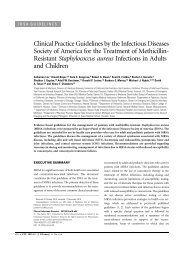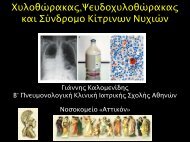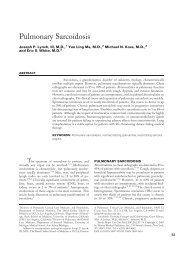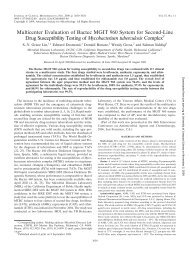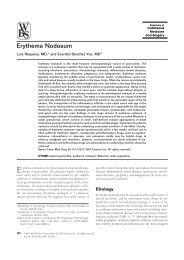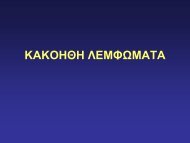Non-Invasive Ventilation
Non-Invasive Ventilation
Non-Invasive Ventilation
Create successful ePaper yourself
Turn your PDF publications into a flip-book with our unique Google optimized e-Paper software.
Επεμβαηικός και μη επεμβαηικός<br />
μητανικός αεριζμός ζηη ΧΑΠ<br />
Θεόδωρος Βαζιλακόποσλος<br />
Αναπληρωηής Καθηγηηής<br />
Ενηαηικής Θεραπείας-Πνεσμονολογίας<br />
Εθνικό και Καποδιζηριακό Πανεπιζηημίο Αθηνών<br />
Νοζοκομείο «ο Εσαγγελιζμός»
► Pathophysiology<br />
Outline<br />
► <strong>Non</strong> invasive ventilation during exacerbations to<br />
avoid intubation<br />
► Controlled mechanical ventilation<br />
► Partial support ventilation<br />
• Ventilator triggering<br />
• Wasted efforts<br />
► Weaning<br />
► <strong>Non</strong> <strong>Invasive</strong> <strong>Ventilation</strong> after weaning<br />
• Spontaneous breathing trial failure<br />
• Post extubation
Pathophysiology<br />
Barnes, P. J. N Engl J Med 2000;343:269-280
Flow Limitation<br />
Hyperinflation
IRV<br />
IRV<br />
Tidal breathing in COPD<br />
V T<br />
V T<br />
Normal<br />
COPD<br />
ERV<br />
ERV<br />
Trapped gas
ERV<br />
IRV<br />
Normal<br />
Hyperinflation<br />
Static Hyperinflation<br />
Dynamic<br />
Hyperinflation<br />
IC<br />
V T<br />
RV<br />
Gas Trapping in resting conditions<br />
Gas Trapping due to exercise
Φυσιολογική αναπνοή
Αναπνοή στη ΧΑΠ
600 ml<br />
PEEPi<br />
600 ml
Flow<br />
Pes<br />
W elastic<br />
W resistive<br />
W PEEPi<br />
P-V curve<br />
reduction bronchial caliber
Decreased zone Apposition<br />
Lower rib retraction
Length Tension Relationship:<br />
Diaphragmatic Weakness
Imbalance Load / Neuromuscular Capacity<br />
Vassilakopoulos T et al Eur Respir J 1996;9:2383-2400
<strong>Non</strong>-invasive ventilation<br />
during exacerbations to<br />
avoid intubation
700<br />
600<br />
500<br />
400<br />
300<br />
200<br />
100<br />
0<br />
-100<br />
PTPdi/min (cmH20 x s/min)<br />
i-PSV n-PSV T-piece S.B.<br />
*<br />
*
% of patients<br />
Intubation rate in patients with acute<br />
exacerbation of COPD treated with and<br />
without NIPPV<br />
80<br />
73 74<br />
70<br />
60<br />
50<br />
40<br />
30<br />
20<br />
10<br />
31<br />
n=16 n=15<br />
26<br />
n=43 n=42<br />
NIPPV<br />
Control<br />
0<br />
Kramer et al 1995 Brochard et al 1995
Hospital stay (days) of patients with acute<br />
exacerbation of COPD treated with and without<br />
NIPPV<br />
80<br />
70<br />
60<br />
50<br />
40<br />
30<br />
20<br />
10<br />
0<br />
*<br />
NIPPV<br />
Control<br />
Brochard et al. NEJM 1995;333:817
% of patients<br />
In-hospital mortality (%) in patients with<br />
acute exacerbation of COPD treated with<br />
and without NIPPV<br />
35<br />
30<br />
30 29<br />
25<br />
20<br />
15<br />
10<br />
5<br />
0<br />
10 9<br />
n=30 n=30<br />
n=43 n=42<br />
Bott et al 1993 Brochard et al 1995<br />
NIPPV<br />
Control
% of patients<br />
Early use of NIPPV for acute exacerbation of<br />
COPD on general wards<br />
30<br />
27<br />
25<br />
20<br />
15<br />
10<br />
15<br />
10<br />
20<br />
NIPPV<br />
Control<br />
5<br />
n=118 n=118 n=118 n=118<br />
0<br />
Need for intubation<br />
In-hospital mortality<br />
Plant et al. Lancet 2000;355:1931
NIV in hypercapnic encephalopathy<br />
Scala et al, Intensive Care Med 2007;33:2101-8
Helmet worsens patient-ventilator interaction in COPD<br />
Navalesi P et al, Intensive Care Med 2007;33:74-81
Controlled mechanical<br />
ventilation
Mechanical <strong>Ventilation</strong><br />
►Volume Control<br />
• Tidal Volume 520 ml<br />
• Respiratory Rate = 16 breaths/min<br />
• TI/TT = 0,25<br />
• PEEP = 0-5 cmH2O<br />
• FiO2 = 50%
Pressure (cmH 2 O)<br />
Flow (l/sec)<br />
1.5<br />
1<br />
0.5<br />
Dynamic hyperinflation<br />
0<br />
-1 -0.5 0 0.5 1 1.5 2 2.5 3 3.5 4<br />
-0.5<br />
-1<br />
-1.5<br />
60<br />
Slope increase<br />
End expiratory flow<br />
50<br />
40<br />
Over-distension<br />
30<br />
20<br />
10<br />
0<br />
-1 -0.5 0<br />
-10<br />
0.5 1 1.5 2 2.5 3 3.5 4<br />
Time (sec)
Assessment of mechanics<br />
Ppeak<br />
Pplateau<br />
PEEPi<br />
End expiratory occlusion<br />
Rrs = (Ppeak-Pplateau)/V’
When PEEPi is present during CMV<br />
► Hemodynamic<br />
compromise<br />
► Overdistension with<br />
risk of barotrauma<br />
► Reduce f<br />
► Reduce VT<br />
► Increase inspiratory<br />
flow to prolong TE
Partial Support Modes
Ventilator triggering
Ptr
Aslanian P, AJRCCM 1998;157:135-43
Partitioning of pressure time product during<br />
flow and pressure triggering<br />
9<br />
Pressure Support<br />
9<br />
Assist control<br />
8<br />
8<br />
7<br />
7<br />
6<br />
5<br />
4<br />
3<br />
PTPes<br />
PTPtr<br />
PTPpost<br />
PTPpeepi<br />
6<br />
5<br />
4<br />
3<br />
PTPes<br />
PTPtr<br />
PTPpost<br />
PTPpeepi<br />
2<br />
2<br />
1<br />
1<br />
0<br />
PT<br />
FT<br />
0<br />
PT<br />
FT<br />
Aslanian P, AJRCCM 1998;157:135-43
Paw (cmH 2 O)<br />
Flow (l/sec)<br />
0.8<br />
0.6<br />
0.4<br />
0.2<br />
0<br />
-2<br />
-0.2<br />
3 8 13 18<br />
-0.4<br />
-0.6<br />
-0.8<br />
35<br />
30<br />
25<br />
20<br />
15<br />
10<br />
5<br />
0<br />
-2<br />
-5<br />
3 8 13 18<br />
Fr = 12 b/min<br />
Time (sec)<br />
5 sec
Pes (cmH 2 O)<br />
Paw (cmH 2 O)<br />
Flow (l/sec)<br />
0,8<br />
0,6<br />
0,4<br />
0,2<br />
0<br />
-2<br />
-0,2<br />
3 8 13 18<br />
-0,4<br />
-0,6<br />
-0,8<br />
35<br />
30<br />
25<br />
20<br />
15<br />
10<br />
5<br />
0<br />
-2<br />
-5<br />
3 8 13 18<br />
20<br />
15<br />
10<br />
5<br />
0<br />
-2 3 8 13 18<br />
-5<br />
Fr = 33 b/min<br />
Time (sec)<br />
5 sec<br />
Georgopoulos D
Ptr
Wasted effort<br />
PEEPi<br />
Ptr<br />
Dynamic<br />
Hyperinflation<br />
Vrel
Ineffective efforts increase as the level of<br />
ventilator support increases<br />
Leung P, AJRCCM 1997;155:1940-48
Ineffective efforts decrease as<br />
expiratory time increases<br />
ACV<br />
Tidal<br />
Volume<br />
constant<br />
Increased<br />
Flow<br />
Increased<br />
Expiratory<br />
time<br />
Kondili E, BJA<br />
2003;91:106-19
Ptr
Factors predisposing to ineffective efforts<br />
►The level of ventilator assistance<br />
►Large tidal volume of the preceding breath<br />
►Short expiratory time<br />
►PEEPi
Pes (cmH 2 O)<br />
Paw (cmH 2 O)<br />
Flow (l/sec)<br />
0.8<br />
0.6<br />
0.4<br />
0.2<br />
0<br />
-2<br />
-0.2<br />
3 8 13 18<br />
-0.4<br />
-0.6<br />
-0.8<br />
35<br />
30<br />
25<br />
20<br />
15<br />
10<br />
5<br />
0<br />
-2<br />
-5<br />
3 8 13 18<br />
20<br />
15<br />
10<br />
5<br />
0<br />
-2 3 8 13 18<br />
-5<br />
Time (sec)<br />
5 sec
Pes (cmH 2 O)<br />
Flow (l/sec)<br />
0,8<br />
0,6<br />
0,4<br />
0,2<br />
0<br />
-0,2<br />
-0,4<br />
-0,6<br />
-0,8<br />
0 1 2 3 4 5 6<br />
14<br />
12<br />
10<br />
8<br />
6<br />
4<br />
2<br />
0<br />
-2<br />
-4<br />
0 1 2 3 4 5 6<br />
Time (sec)<br />
5 sec<br />
Georgopoulos D
Wasted efforts reduction during pressure support<br />
Cycling off criterion<br />
increased<br />
in steps of 10%<br />
Thille et al Intensive Care<br />
Med 2008;34:1477-86<br />
Gradual reduction<br />
of PS level-steps of 2 cmH 2 0
Addition of external PEEP<br />
Ptr<br />
PEEP external
Chao et al, Chest 1997;112:1592-9<br />
Asynchrony between patient – ventilator<br />
► Presence of Dynamic Hyperinflation and PEEPi.<br />
Apply external PEEP (~ 5 cmH 2 O)
Weaning
Pressure Support vs T-piece weaning in COPD<br />
COPD Screened<br />
77 patients<br />
Excluded<br />
2<br />
Eligible T-tube trial<br />
75<br />
Trial Success<br />
23 (31%)<br />
Trial Failure<br />
52 (69%)<br />
T-tube<br />
26<br />
PS<br />
26<br />
Successful Weaning<br />
20 (77%)<br />
Successful Weaning<br />
19 (73%)<br />
Failed Weaning<br />
6 (23%)<br />
Failed Weaning<br />
7 (27%)<br />
Vitacca et al. Am J Respir Crit Care 2001; 164: 225
PSV<br />
T-piece<br />
AJRCCM 2001;164:225-230.
<strong>Non</strong> <strong>Invasive</strong> <strong>Ventilation</strong> as weaning technique<br />
in COPD patients who fail SBT after 2 days of MV<br />
NIV<br />
Nava et al. Ann Intern Med 1998;128:721
% of patients<br />
60 days mortality (%) in patients with<br />
acute exacerbation of COPD<br />
using NIPPV as a weaning technique<br />
40<br />
35<br />
30<br />
28<br />
*<br />
25<br />
20<br />
15<br />
10<br />
5<br />
0<br />
8<br />
NIPPV<br />
Control<br />
Nava et al. Ann Intern Med 1998;128:721
<strong>Non</strong> <strong>Invasive</strong> <strong>Ventilation</strong> during persistent<br />
(3 days) spontaneous breathing trial failure<br />
NIV<br />
NIV<br />
COPD 25/43 patients<br />
Ferrer et al. Am J Respir Crit Care Med 2003;168:70-76
<strong>Non</strong>-<strong>Invasive</strong> <strong>Ventilation</strong><br />
(n.114)<br />
Conventional Therapy<br />
(n.107)<br />
Absolute Risk Difference<br />
Relative Risk (95% CI)<br />
p-value<br />
Mortality<br />
25%<br />
14%<br />
11.4% (0.85-21.63)<br />
1.75 (0.99-3.09)<br />
0.05<br />
Reintubation<br />
49%<br />
49%<br />
0%<br />
0.99 (0.76-1.30)<br />
ns
Did this RCT “killed” NIV ?
Mortality %<br />
80<br />
70<br />
60<br />
6/9<br />
50<br />
40<br />
30<br />
7/14<br />
General<br />
COPD<br />
20<br />
10<br />
28/114<br />
*<br />
15/107<br />
0<br />
NIV<br />
Standard therapy<br />
Esteban, A. et al. N Engl J Med 2004;350:2452-2460
TIME to REINTUBATION<br />
%<br />
80<br />
70<br />
60<br />
50<br />
40<br />
30<br />
20<br />
10<br />
0<br />
patients<br />
deaths<br />
0-12 hr<br />
13-24 hr<br />
25-48 hr<br />
49-72 hr<br />
Epstein and Ciubotaru AJRCCM 1998;158:489-93
Another way to see the problem:<br />
If timing is a key factor, why should<br />
we wait until post-extubation<br />
respiratory failure is overt ?
NIV to prevent extubation failure<br />
in patients with successful SBT<br />
Αναπνεσζηική<br />
ανεπάρκεια<br />
33%<br />
16%<br />
Ferrer et al. Am J Respir Crit Care Med 2006;173:164-70
Survival of patients receiving NIV to prevent<br />
extubation failure in patients with successful SBT<br />
subgroup<br />
analysis<br />
Ferrer et al. Am J Respir Crit Care Med 2006;173:164-70
Ferrer et al, Lancet 2009;374:1082-88
NIV after extubation in patients who develop<br />
hypercapnia during a spontaneous breathing trial<br />
Ferrer et al, Lancet 2009;374:1082-88
Time elapsed from extubation to development of<br />
respiratory failure<br />
NIV immediately after extubation<br />
in patients who develop hypercapnia during a spontaneous breathing trial<br />
Ferrer et al, Lancet 2009;374:1082-88
► NIV is beneficial<br />
Summary<br />
• To avoid intubation<br />
• When spontaneous breathing trial fails in COPD<br />
• To prevent extubation failure in COPD patients<br />
► During CMV check mechanics and PEEPi<br />
• To avoid hemodynamic compromise<br />
• To avoid overdistention<br />
► Triggering: not really clinically important<br />
► Wasted efforts<br />
• Decrease support<br />
• Apply external PEEP<br />
► Weaning: No difference between different techniques<br />
• PS vs T-piece<br />
• The best technique is the one you know well



